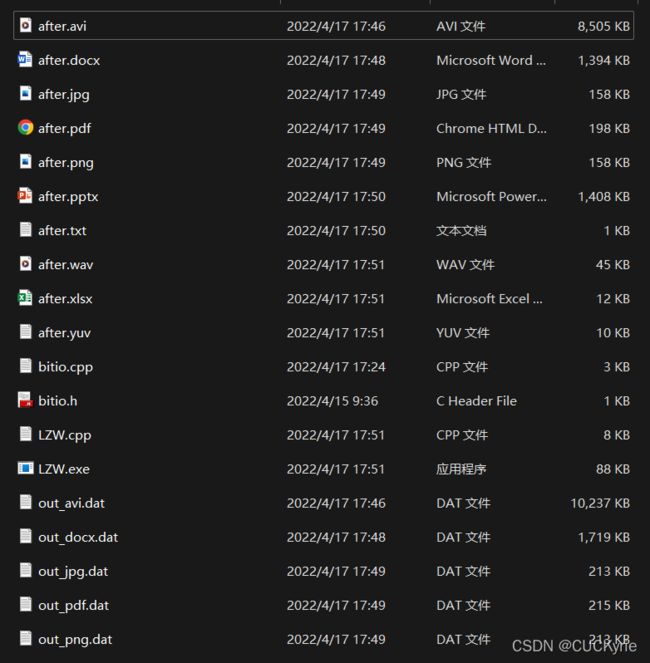LZW算法原理及实现
文章目录
- LZW算法原理及实现
-
- LZW算法原理
- LZW编码过程
- LZW解码过程
- 实验过程实现
-
- 位输入输出工具
- 编解码
- 实验结果
-
- 对于单个Txt文件
- 多种类型的文件
- 实验结论
LZW算法原理及实现
LZW算法原理
LZW属于第二类词典编码,其基本思想是:企图从输入的数据中创建一个“短语词典”,这种短语词典可以是任意字符的组合。编码数据过程中,当遇到已经在字典中出现的“短语”时,编码器就输出这个词典中的短语的“索引号”,而不是短语本身。
LZW编码过程
编码的流程大致如下:
步骤1:将词典初始化为包含所有可能的单字符,当前前缀P初始化为空。
步骤2:当前字符C = 字符流中的下一个字符。
步骤3:判断P+C是否在词典中:
-
如果“是”,则用C扩展P,即让P = P+C,返回到步骤2。
-
如果“否”,则输出与当前前缀P相对应的码字W并将P+C添加到词典中,
令P = C,并返回到步骤2。
LZW解码过程
解码的流程大致如下:
步骤1:在开始译码时词典包含所有可能的前缀根。
步骤2:令CW=码字流中的第一个码字。
步骤3:输出当前字符串CW到码字流。
步骤4:先前码字PW=当前码字CW。
步骤5:当前码字CW=码字流的下一个码字。
步骤6:判断当前字符串CW是否在词典中。
如果”是”,则把当前字符串CW输出到字符流。
- 当前前缀P = PW。
- 当前字符C=当前字符串的第一个字符。
- 把P + C添加到词典。
- PW = CW
如果”否”,则当前前缀P = PW。
- 当前字符C=先前字符串PW的第一个字符。
- 输出P + C到字符流,然后把它添加到词典中。
- PW = CW
实验过程实现
位输入输出工具
由于索引号会产生大于255的情况,所以1byte肯定是不够的,但如果直接开到int又会造成资源浪费,所以我们需要根据实际的字典大小来确定位数,这就需要按位输入输出工具了:
/*
* Declaration for bitwise IO
*
* vim: ts=4 sw=4 cindent
*/
#ifndef __BITIO__
#define __BITIO__
#include 函数实现如下:
/*
* Definitions for bitwise IO
*
* vim: ts=4 sw=4 cindent
*/
#include 编解码
我们使用Trie树来构建编解码所需要的词典,但是需要注意的是:编码器端是从根节点开始构建一棵树,但是在解码端却是从叶子节点开始回退到根节点上,这里的顺序会影响我们后续代码的编写:
/*
* Definition for LZW coding
*
* vim: ts=4 sw=4 cindent nowrap
*/
#include \n" , argv[0]);
fprintf( stdout, "\t: E or D reffers encode or decode\n" );
fprintf( stdout, "\t: input file name\n" );
fprintf( stdout, "\t: output file name\n" );
return -1;
}
if('E' == argv[1][0]){ // do encoding
fp = fopen(argv[2], "rb");
bf = OpenBitFileOutput( argv[3]);
if( NULL!=fp && NULL!=bf){
LZWEncode( fp, bf);
fclose( fp);
CloseBitFileOutput( bf);
fprintf( stdout, "encoding done\n");
}
}else if('D' == argv[1][0]){ // do decoding
bf = OpenBitFileInput( argv[2]);
fp = fopen( argv[3], "wb");
if( NULL!=fp && NULL!=bf){
LZWDecode( bf, fp);
fclose( fp);
CloseBitFileInput( bf);
fprintf( stdout, "decoding done\n");
}
}else{ // otherwise
fprintf( stderr, "not supported operation\n");
}
return 0;
}
实验结果
对于单个Txt文件
将如下的txt文件进行处理:

代码跑出来的结果如下:

效果还是很理想的。
多种类型的文件
我们选取了txt、png、wav、yuv等10种格式的文件进行LZW编解码实验,并得到了不同文件格式的压缩比:

压缩比对比如下表所示:
| 文件类型 | 编码前大小 | 编码后大小 | 压缩比 |
|---|---|---|---|
| txt | 9 bytes | 16 bytes | 56.25% |
| yuv | 9.37 KB | 5.65 KB | 165.84% |
| 197 KB | 214 KB | 92.05% | |
| xlsx | 11.1 KB | 19.4 KB | 57.21% |
| docx | 1.36 MB | 1.67 MB | 81.43% |
| avi | 8.30 MB | 9.99 MB | 83.08% |
| wav | 44.2 KB | 54.8 KB | 80.65% |
| jpg | 157 KB | 212 KB | 74.05% |
| png | 157 KB | 214 KB | 73.36% |
| pptx | 1.37 MB | 1.70 MB | 80.58% |
实验结论
从上表可以看出,LZW在某些文件格式上表现出了很好的压缩效果,而在大部分现有的文件格式中压缩效果并不理想,原因可能有两点:
- 绝大部分通用的文件格式本身都是经过压缩的,再使用LZW算法进行压缩可能适得其反,但是像yuv这类未经压缩的数据格式,使用LZW算法后的压缩效果就很可观。
- 文件的编码格式要求限制,一部分文件中字符的重复概率很高,而另一部分文件中字符的重复概率很低,造成了LZW在压缩不同文件时展现出相反的效果。
总结来说,LZW算法还存在很大的优化空间,比如我们可以加入霍夫曼编码对索引二次编码等。相比之下,LZW算法更适用于大文件(重复的可能性较大),和内容重复率较高的文件。